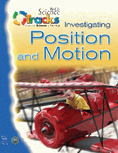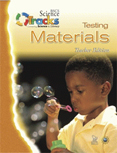Search Listing Name
product:
BSCS Science Tracks: Connecting Science And Literacy: Solving Air Pollution Problems Teacher Edition
SCIENCE & TECHNOLOGY-Students investigate two types of pollution problems, one personal and one environmental. First, students investigate the effects on the respiratory system of cigarette smoking. They explore the respiratory system and determine how it helps us meet our needs for air. Then, they determine that smoking interferes with the functioning of the respiratory system and reduces its ability to function. Second, students investigate some causes of air pollution in the environment, explore the harmful effects of air pollution
product:
BSCS Science Tracks: Connecting Science And Literacy: Investigating Plants Student Guide
LIFE SCIENCE-In this module, the students plant bean seeds in plastic bag "greenhouses" and observe the growth of the bean plants. In doing so, they learn about the needs of plants and seeds as living organisms and explore what happens if a plant's needs are not met. The students practice the skills of inquiry by setting up and monitoring investigations of their bean plants and develop skills such as observing, recording, measuring, comparing, and analyzing. Students keep journals of plant growth and development and learn about the structu
product:
BSCS Science Tracks: Connecting Science And Literacy: Investigating The Changing Earth Student Guide
EARTH & SPACE SCIENCE-This module continues students' investigations of earth materials--soils, rocks, and water--that began in Level 1. In this module, students build on their understanding of the properties of soil, rocks, and water by investigating changes on the surface of Earth due to weathering and erosion. They learn about land forms and how those land forms change over time because of the interactions among soil, rocks, water, and wind. Students construct and use stream tables to investigate the flow of water over Earth's surfa

product:
BSCS Science Tracks: Connecting Science And Literacy: Investigating Position And Motion Student Guide
PHYSICAL SCIENCE-In this module, the students learn about "relative position" and motion of objects. They learn how to describe accurately the position of an object relative to themselves and to another reference object by using terms, such as "in front of," "to the left of," "in back of," "to the right of," and by measuring distances from one object to another. They represent the position of objects on self-made maps and relate their maps to those of city streets and of stores in the shopping mall. They learn that objects move in many dif

product:
BSCS Science Tracks: Connecting Science And Literacy: Testing Materials Teacher Edition
SCIENCE & TECHNOLOGY-In this module, students investigate the materials from which objects are made. They discover that all materials have properties, such as color, hardness, transparency, and absorbency, and that people select a material for a certain purpose according to the properties of the material. Students compare materials in terms of their response to puffs of air and water. They compare structures that are made of different materials and explain why certain structures are made of specific materials.
product:
BSCS Science Tracks: Connecting Science And Literacy: Investigating Plants Teacher Edition
LIFE SCIENCE-In this module, the students plant bean seeds in plastic bag "greenhouses" and observe the growth of the bean plants. In doing so, they learn about the needs of plants and seeds as living organisms and explore what happens if a plant's needs are not met. The students practice the skills of inquiry by setting up and monitoring investigations of their bean plants and develop skills such as observing, recording, measuring, comparing, and analyzing. Students keep journals of plant growth and development and learn about the structu
Pagination
- First page
- Previous page
- Page 1
- Page 2
- Current page 3
- Page 4
- Page 5
- Page 6
- Page 7
- Next page
- Last page
